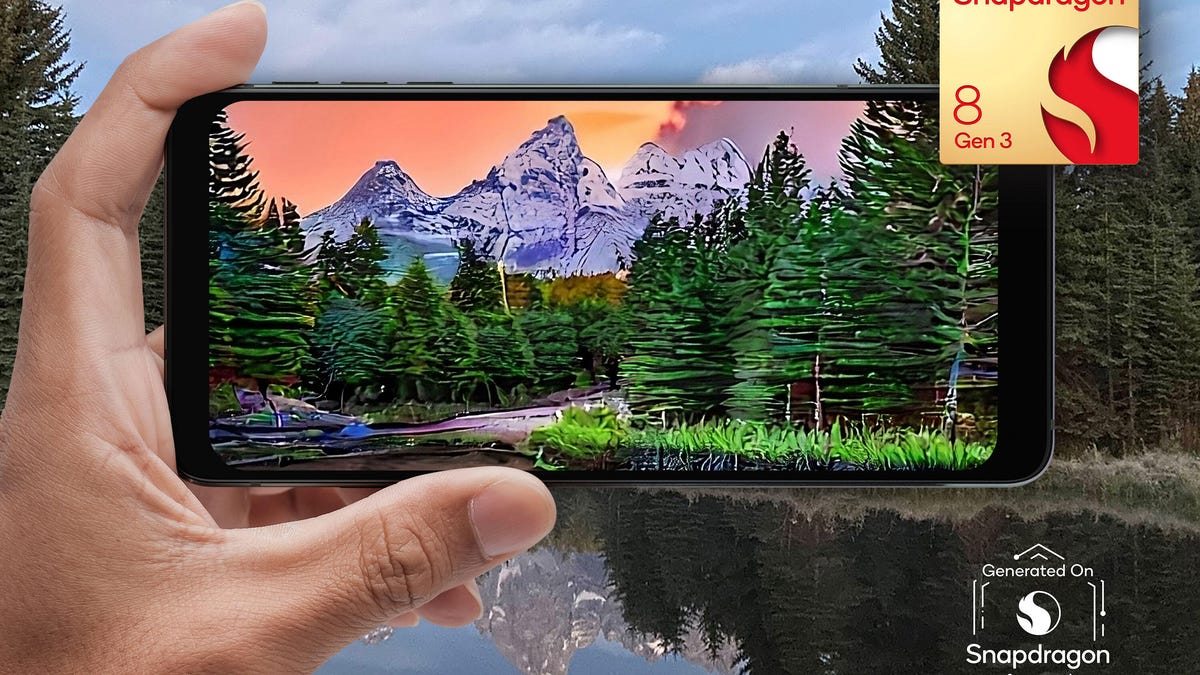2023 Has Been the Year of Generative AI. It's Coming to Phones in 2024
Qualcomm's next Snapdragon chips bring new AI to phones. Here's what it means for phone owners.

Qualcomm announced the Snapdragon 8 Gen 3 at its Snapdragon Summit.
Generative AI has been all the rage in 2023, with folks using ChatGPT, Midjourney and other tools to create text, images and more. But all those solutions have relied on cloud computing to tap into billions of conditions called parameters that answer user queries. At its annual Snapdragon Summit in Hawaii, Qualcomm announced on Tuesday that its next line of Snapdragon mobile chips will enable smartphones to use generative AI wherever they are -- even offline.
Qualcomm hasn't been shy about bringing AI-based features to its chips, and now the company has revealed details on how that will change what everyone's phones can do. The Snapdragon 8 Gen 3 will power next year's top Android phones, likely including the Samsung Galaxy S24 series in January or February. Those phones will be capable of using on-device generative AI offline, and since they won't be connected to the cloud, they can take personal data into consideration when making recommendations.
But the world won't have to wait too long to see what the Snapdragon 8 Gen 3 is capable of. At the Summit, Xiaomi Group president William Lu revealed that the Xiaomi 14, which uses the chipset, will launch on Thursday. The phone will use Xiaomi's own proprietary AI model.
Phones running the Snapdragon 8 Gen 3 won't natively be able to access generative AI features -- their manufacturers will have to work with Qualcomm on integrating AI into their devices. Brands including ASUS, Honor, Nubia, OnePlus, Oppo, realme, Sony, Xiaomi and ZTE have committed to adopting the chip into their forthcoming premium phones, though it remains to be seen how many of the Snapdragon 8 Gen 3's AI capabilities will be integrated into the devices being sold next year.
As it stands, it will be available only on top-end phones anyway and could take years before the AI features trickle down to more affordable models -- and therefore seeded out into the worldwide population of phones.
But Qualcomm is still bullish about the potential of AI on phones to change how we use them -- which the company believes will be a generational shift in possibility.
"In the 4G era, we started to see [phones] become computers, and smartphones have become the largest developer platform created by mankind," Qualcomm CEO Cristiano Amon said Tuesday on stage at Snapdragon Summit. "We're beginning to see the next transition [in phones], and it's going to be as profound."
Qualcomm had already announced it was teaming up with Microsoft and Meta on the Llama 2 generative AI. The Snapdragon 8 Gen 3 supports over 10 billion parameters in AI, and is capable of running language learning models at up to 20 tokens per second. Qualcomm says the chip will have over 20 language learning models supported at launch.
The Snapdragon 8 Gen 3's performance speeds up on-device AI. At Mobile World Congress back in February, Qualcomm showed off an on-device demonstration for getting Stable Diffusion to generate an image in around 15 seconds -- and the new mobile chipset speeds that up to under a second.
More uniquely, Qualcomm uses what it calls "on-device personalization" to combine user data from a "Sensing Hub" (cameras, sensors, modem, Wi-Fi and other components) that uses favorite activities, fitness levels, location and other behaviors to make smarter suggestions. Qualcomm didn't have specific examples for how this could be implemented, but given how much generative AI has been used on images, it's no surprise that the company has more ideas for how on-device AI can improve its cameras.
While shooting from the front and rear camera has been around since the Samsung Galaxy S4, a new feature called Vlogger View inserts the person holding the phone (sans background) into the bottom corner of the video, no special software required. And much like Adobe's recently revealed cloud-based tool to expand a photo beyond its original borders, the Snapdragon 8 Gen 3 can expand a photo by having AI fill in the area beyond the original bounds of the image.
The Snapdragon 8 Gen 3 can also have the camera continuously scan while the phone is locked, enabling devices to passively recognize things like QR codes or human faces (if someone pops up behind you, it can lock the phone to prevent someone from snooping on your personal info).
And as much as generative AI is important, asserting what is and isn't produced with AI is just as crucial. Phones with Snapdragon 8 Gen 3 have Truepic, which watermarks photos users shoot with the C2PA standard, giving them a cryptographic seal to prove images are real and not AI-generated.
Editors' note: CNET is using an AI engine to help create some stories. For more, see this post.

